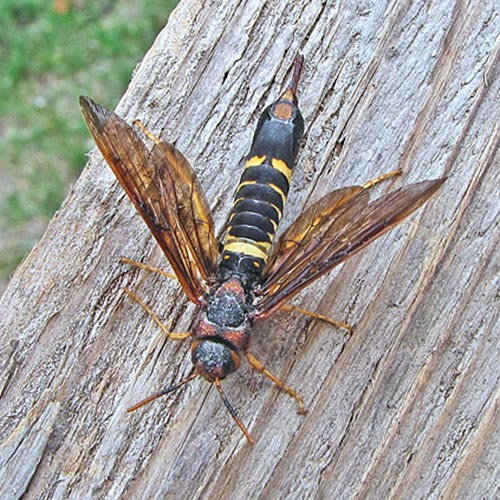Howdy, BugFans,
The BugLady’s computer has just taken a week off to have a hard-drive transplant, so the BugLady offers this BOTW from five years ago. She photographed a horntail on the prairie recently and has heard reports of others.
Pigeon Horntail
The impressive Pigeon Horntail is a primitive member of the ant/wasp/bee order—Hymenoptera (“membrane wings”). Most Hymenopterans boast a cinched-in/Scarlet O’Hara waist. Not so the horntail; its cylindrical abdomen plugs directly into its cylindrical thorax. Its name doesn’t come from the long projection at the rear of its abdomen—this is a female and that’s an ovipositor (egg-depositor), and the males don’t have one. But, on the top (dorsal) side of the abdomen, at its tip, is a triangular “plate” or “horn,” best seen in the side view, which gives Horntails their name. While the gentle, just-under-two-inch-long horntail looks dangerous, it neither bites nor stings. The horntail posing on the wood fence bounced off the BugLady one day, and she treated it to a few hours in the refrigerator so she could photograph it.
Horntails (family Siricidae) are often called “wood wasps” because their eggs are laid in wood and their young spend both their larval and pupal stages there. Horntails practice “complete metamorphosis,” going through an egg stage, a larval (eating) stage and a pupal (resting/changing) stage before emerging as a very different-looking adult. Adults have been found emerging into the interior of buildings that were built with the wood they occupied, and they sometimes find themselves in a different country than the one in which they began their life.
Ms. Pigeon Horntail (Tremex columba) drills into hardwoods, like maple and oak, with her ovipositor. Then she lays her eggs in the newly-made tunnel, and then she deposits on them some fungal spores, which she carries in a handy “pocket” in her abdomen. The fungus starts to grow, rotting the surrounding wood. When the eggs hatch, the “pre-treated” wood is softened so they can eat and tunnel more easily. She may expire as the final egg is laid (several references quoted each other on this point, but technically, if she has expired, then it was her final egg, regardless). It is, apparently, not uncommon to find dead females with their ovipositor still stuck in a tree.
[metaslider id=2530]
Both the larvae and the adults have mouthparts designed for chewing, though the adults eat only nectar and water. Larvae feed on wood in the relative (but not complete) safety of the tree for up to two years. They are sometimes considered pests; the trees that Mom picks are usually stressed/dead/dying already, but neither the larval feeding nor the wood-softening fungus improves either the tree’s health or the value of its timber. When they are ready to pupate, the larvae tunnel to within striking distance of the tree’s inner bark and construct a cocoon of silk and small bits of wood. The holes they ultimately emerge through are noticeable.
[metaslider id=2533]
Adaptations seem to spawn more adaptations in response. The larvae of the Giant ichneumon wasp (Megarhyssa sp.) (two species are pictured here) are parasites on horntail larvae. But how, since the horntails are, by most standards, inaccessible, do they get together? Ms. Ichneumon (ichneumon comes from the Greek word for tracker) is a large wasp that trails three long, slender filaments—about 3 inches long—behind her as she flies. One of the three filaments is an ovipositor that she curls up over her body while drilling for horntails, and the other two surround it to form a sheath that strengthens it.
She may have the ability to lay her antennae on the bark and pick up the vibrations of horntail larvae gnawing away in their wood chambers; alternatively, she uses her antennae to smell their frass (droppings) and the wood-softening fungus. Then she “precision-bores” into the chamber with her ovipositor and lays an egg on a horntail larva (alternatively, she threads her hair-like ovipositor through existing cracks in the wood). Because her egg is very liquid, it can travel through the thread-like ovipositor. The ichneumon larva acts as an external parasite of the horntail larva, which stays alive until the ichneumon is ready to pupate. The adult ichneumon, also equipped with chewing mouthparts, uses them to exit the tunnel.
[metaslider id=2536]
The male Megarhyssa Ichneumon wasp is reminiscent of a damselfly. Females have been photographed eating, but it’s not known if males eat.
The BugLady
